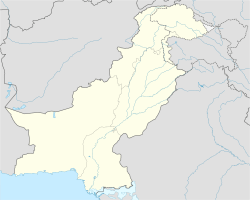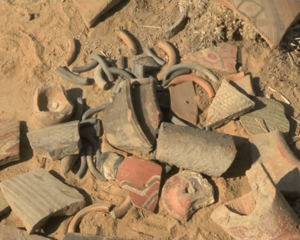Sheri Khan Tarakai facts for kids
| Location | Pakistan |
|---|---|
| Region | Khyber Pakhtunkhwa |
| Coordinates | 32°50′40″N 70°28′08″E / 32.844444°N 70.468889°E |
Sheri Khan Tarakai is an ancient village site in Pakistan. It is located in the Bannu District of the Khyber Pakhtunkhwa province. People lived here a very long time ago, from about 5000 BC to 2500 BC.
Archaeologists have dug up the site to learn about it. They found that Sheri Khan Tarakai was a small village. Only a few hundred people might have lived there at any one time. They built their homes with mud walls. Some houses even had stone foundations and flat roofs made of wattle and daub (a mix of sticks and mud).
Contents
Where is Sheri Khan Tarakai?
Sheri Khan Tarakai is about 17 kilometers (10.5 miles) southwest of Bannu City. The Bannu area is a basin, which is like a bowl-shaped land. It sits next to the hills of Afghanistan and Waziristan to the west. To the east is the wide Indus River floodplain.
Another old site from the same time, called Rehman Dheri, is about 100 kilometers (62 miles) south. It is also in the Khyber Pakhtunkhwa province.
How We Know About Sheri Khan Tarakai
The site of Sheri Khan Tarakai was first found in 1985. This was done by a group called the Bannu Archaeological Project. It is the oldest known village in the Bannu region. Archaeologists dug at the site for five seasons, from 1986 to 1990.
The Bannu Archaeological Project
The Bannu Archaeological Project was a team of experts. They explored the Bannu District in Pakistan from 1985 to 2001. They found many ancient sites, both from early history and older times.
This project discovered that Sheri Khan Tarakai is the second oldest farming village in all of South Asia.
Lewan Settlement
Between 1995 and 2001, the project also explored another ancient site called Lewan, Bannu. This site was used during different time periods. It helps us understand how complex societies started in this area long ago.
Lewan was used continuously for a very long time, from about 4000 BC to 2000 BC. People there made beads and pottery. This was similar to what people did at other sites in the Bannu area, like Tarakai Qila and Islam Chowki.
Akra, Bannu
The project also looked at Akra, Bannu, which is an early historical site. Akra is very large, covering about 80 hectares (almost 200 acres). People first lived there around 2000 BC. They might have stayed there until the 11th century AD.
Life in Sheri Khan Tarakai
The people of Sheri Khan Tarakai used many types of pottery pots. These pots had cool designs, like geometric shapes and pictures of animals or people. They probably made these pots from clay found nearby.
They also made stone tools from local materials. Many small objects, like clay human figures, were also made from local materials. Finding these items and the waste from making them shows us what crafts they did. They fired pottery, worked with bone, flaked stone, ground stone, and drilled beads. The many clay figures and designs on the pots suggest they had a rich artistic tradition.
The villagers got their food in several ways. They grew barley and wheat. They also raised sheep, goats, and cattle. They collected wild plants and wood. And they hunted many kinds of wild animals.
They had many grinding tools, which means they processed grains like wheat and barley. They didn't seem to kill many young animals. This suggests they used animals mainly for meat. But they might also have used them for wool, milk, work, and even their dung (poop) for fuel or fertilizer.
The village was located where water from hills would flow down. This means they likely used "flood-water farming," using the water that came after rains. They had storage places, which suggests they lived there all year. But some people might have moved their animals around, a practice called transhumance, to find better grazing lands.
Sheri Khan Tarakai's Place in History
Sheri Khan Tarakai and other sites in the Bannu basin show a culture that didn't change much for a long time. Sheri Khan Tarakai was lived in from the late 4000s BC to the early 2000s BC.
Other Similar Ancient Sites
Sheri Khan Tarakai was used at the same time as other important early villages. These include Mehrgarh (Periods III-V), Kili Gul Mohammad (Periods III-IV), and Rana Ghundai (Periods I-II). These sites are all in the borderlands of South Asia.
Sheri Khan Tarakai seems to be a bit older than some major sites on the plains of Punjab, like Harappa (Period Ia - Ravi phase).
The pottery found at Sheri Khan Tarakai is very similar to pottery from northern Baluchistan (the Togau phase). This type of pottery is also found at Mehrgarh Period III and Kili Gul Mohammed III.
See also
- District Bannu
- Bannu Museum
- Indus Valley civilization
- Ghoriwala



